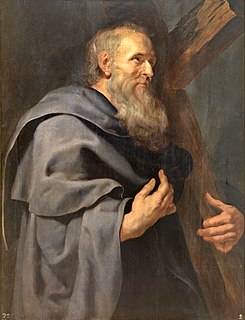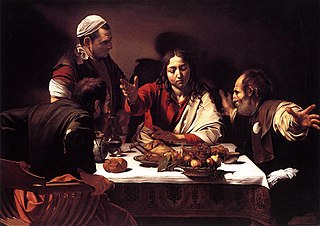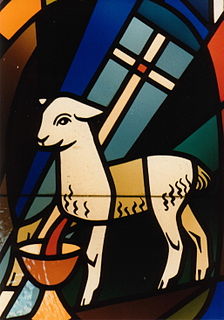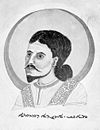Related Research Articles

The Gospel according to Mark, also called the Gospel of Mark or simply Mark, is the second of the four canonical gospels and of the three synoptic Gospels. It tells of the ministry of Jesus from his baptism by John the Baptist to his death, burial, and the discovery of his empty tomb. There is no miraculous birth or doctrine of divine pre-existence, nor, in the original ending, any post-resurrection appearances of Jesus. It portrays Jesus as a teacher, an exorcist, a healer, and a miracle worker. He refers to himself as the Son of Man. He is called the Son of God, but keeps his messianic nature secret; even his disciples fail to understand him. All this is in keeping with Christian interpretation of prophecy, which is believed to foretell the fate of the messiah as suffering servant. The gospel ends, in its original version, with the discovery of the empty tomb, a promise to meet again in Galilee, and an unheeded instruction to spread the good news of the Resurrection of Jesus.

Manichaeism was a major religion founded in the 3rd century AD by the Parthian prophet Mani, in the Sasanian Empire.

The resurrection of Jesus is the Christian belief that God raised Jesus on the third day after his crucifixion, starting – or restoring – his exalted life as Christ and Lord. According to the New Testament writings he was firstborn from the dead, ushering in the Kingdom of God. He appeared to his disciples, calling the apostles to the Great Commission of proclaiming the Gospel of eternal salvation through his death and resurrection, and ascended to Heaven.

Eunomius, one of the leaders of the extreme or "anomoean" Arians, who are sometimes accordingly called Eunomians, was born at Dacora in Cappadocia or at Corniaspa in Pontus. early in the 4th century.

Philip the Apostle was one of the Twelve Apostles of Jesus according to the New Testament. Later Christian traditions describe Philip as the apostle who preached in Greece, Syria, and Phrygia.
Leucius, called Leucius Charinus by Photios I of Constantinople in the ninth century, is the name applied to a cycle of what M. R. James termed "Apostolic romances" that seems to have had wide currency long before a selection was read aloud at the Second Council of Nicaea (787) and rejected. Leucius is not among the early heretical teachers mentioned by name in Irenaeus' Adversus haereses. Most of the works seem to have come into existence in the mid-third century.

Mani, of Iranian origin, was the prophet and the founder of Manichaeism, a religion of late antiquity strongly influenced by Gnosticism which was once widespread but is no longer prevalent by name.

In Christianity, disciple primarily refers to a dedicated follower of Jesus. This term is found in the New Testament only in the Gospels and Acts. In the ancient world, a disciple is a follower or adherent of a teacher. It is not the same as being a student in the modern sense. A disciple in the ancient biblical world actively imitated both the life and teaching of the master. It was a deliberate apprenticeship which made the fully formed disciple a living copy of the master.
In 4th-century Christianity, the Anomoeans, and known also as Heterousians, Aetians, or Eunomians, were a sect that upheld an extreme form of Arianism, that Jesus Christ was not of the same nature (consubstantial) as God the Father nor was of like nature (homoiousian), as maintained by the semi-Arians.

The post-resurrection appearances of Jesus in the canonical gospels are reported to have occurred after Jesus' death, burial and resurrection, but prior to his ascension. Among these sources, most scholars believe the First Epistle to the Corinthians was written first. Most Christians point to the appearances as evidence of his bodily resurrection and identity as Messiah, seated in Heaven on the right hand of God. Others, including Liberal Christians, interpret these accounts as visionary experiences.
The Arian controversy was a series of Christian disputes about the nature of Christ that began with a dispute between Arius and Athanasius of Alexandria, two Christian theologians from Alexandria, Egypt. The most important of these controversies concerned the relationship between the substance of God the Father and the substance of His Son.

The following outline is provided as an overview of and topical guide to Christianity:
Habib the Carpenter, or Habib Al-Najjar, was, according to the belief of some Muslims, a martyr who lived in Antioch at the time of Jesus Christ. In Muslim tradition, Habib believed the message of Christ's disciples sent to the People of Ya-Sin, and was subsequently martyred for his faith. The Mosque of Habib-i Neccar, below Mount Silpius, contains the tomb of Habib along with that of Sham'un Al-Safa. Some sources have identified Habib with Saint Agabus of the Acts of the Apostles, an early Christian who suffered martyrdom in Antioch at the time of Jesus. This connection is disputed, as Christian tradition holds that Agabus was martyred at Jerusalem, and not at Antioch as Muslims believe of Habib. All Muslim sources list Habib's occupation as a carpenter.

For the majority of Christian denominations, the Holy Spirit, or Holy Ghost, is believed to be the third person of the Trinity, a Triune God manifested as God the Father, God the Son, and God the Holy Spirit, each entity itself being God. Nontrinitarian Christians, who reject the doctrine of the Trinity, differ significantly from mainstream Christianity in their beliefs about the Holy Spirit. In Christian theology, pneumatology is the study of the Holy Spirit. Due to Christianity's historical relationship with Judaism, theologians often identify the Holy Spirit with the concept of the Ruach Hakodesh in Jewish scripture, on the theory that Jesus was expanding upon these Jewish concepts. Similar names, and ideas, include the Ruach Elohim, Ruach YHWH, and the Ruach Hakodesh. In the New Testament it is identified with the Spirit of Christ, the Spirit of Truth, the Paraclete and the Holy Spirit.

In Christian theology and ecclesiology, the apostles, particularly the Twelve Apostles, were the primary disciples of Jesus according to the New Testament. During the life and ministry of Jesus in the 1st century AD, the apostles were his closest followers and became the primary teachers of the gospel message of Jesus. There is also an Eastern Christian tradition derived from the Gospel of Luke of there having been as many as seventy apostles during the time of Jesus' ministry.

The historicity and origin of the resurrection of Jesus has been the subject of historical research and debate, as well as a topic of discussion among theologians. The accounts of the Gospels, including the empty tomb and the appearances of the risen Jesus to his followers, have been interpreted and analyzed in diverse ways, and have been seen variously as historical accounts of a literal event, as accurate accounts of visionary experiences, as non-literal eschatological parables, and as fabrications of early Christian writers, among various other interpretations. It has been suggested, for example, that Jesus did not die on the cross, that the empty tomb was the result of Jesus' body having been stolen, or, as was common with Roman crucifixions, that Jesus was never entombed.
Aphthonius of Alexandria is mentioned by church historian Philostorgius as a learned and eloquent bishop of the Manichaeans. He is mentioned as a disciple and commentator of the prophet Mani by Photios I of Constantinople and Peter of Sicily, and in the form of abjuring Manichaeism.
Florentius of Constantinople was the rival Anomoean archbishop of Constantinople, holding the office at the same time as and in opposition to Eudoxius of Antioch.
Manichaean scripture includes nine main books: the Seven Treatises of Manichaeism, all personally written by Mani in Syriac, the Shabuhragan written by Mani in Middle Persian, and the Arzhang, a series of illustrations painted by Mani

In Manichaeism, Jesus is considered one of the four prophets of this religion, along with Zoroaster, Gautama Buddha and Mani. He is also a "guiding deity" who greets the light bodies of the righteous after their deliverance.
References
- 1 2 3 Obolensky, Dimitri. The Bogomils: a Study in Balkan Neo-Manichaeism. Pages 25-26. Anthony C. Hall, 1972 (reprint)
- ↑ Schneemelcher, Wilhelm & Robert McLachlan Wilson. New Testament Apocrypha: Writings Relating to the Apostles Apocalypses and Related Subjects. Page 91. John Knox Press, 2003.
- 1 2 3 4 Lieu, Samuel N.C. Manichaeism in the Later Roman Empire and Medieval China: a Historical Survey. Pages 106-107. Manchester University Press, 1985.
- ↑ Smith, Henry & Henry Wace. A Dictionary of Christian Biography, Literature, Sects and Doctrines, Vol. I. Page 58. John Murray, 1877.
- ↑ MacDonald, Dennis Ronald. Christianizing Homer: the Odyssey, Plato, and the Acts of Andrew. Page 94. Oxford University Press, 1994.
